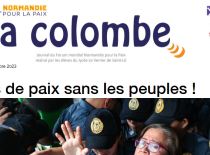The NORMANDY index, explained by its creator: Steve Killelea, founder of the Institute for Economics and Peace.
Calculated on a scale of 0 to 10, using the most reliable sources available (UN, World Bank etc.), the Normandy index establishes a country ranking for the entire world, using a colour code. It correlates 11 dangers which threaten peace: climate change, cyber security, economic crises, energy dependence, fragile states, the murder rate, freedom of the press, terrorism, armed conflicts and weapons of mass destruction. This index is a tool devised by the European Parliament’s research department, designed to inform Europe's political choices.
Synthesis of the presentation of the Normandy Index during the 2019 forum
Peace is not only defined by the absence of war but also by a state’s ability to create an egalitarian society, to protect human rights and fundamental freedoms and to provide its citizens with a reliable, sustainable environment.
The idea of an index which would consider all these aspects emerged from the partnership between the European Parliament and the Normandy Region. The Normandy Index is the result of a research project conducted by the Institute for Economics and Peace which includes eleven indicators, including murder rates, climate change, press freedom and terrorism.
As a barometer of threats to world peace, it measures a state’s vulnerability to conflict. More than a hundred and thirty countries were assessed for this new indicator, which has two main objectives.
Firstly, it aims to provide a coherent picture of the global security environment, based on a thorough scientific methodology. It differs from other similar indices established by the UN and the World Bank in its subject of analysis: rather than focusing on the risks which affect individuals, it assesses the hybrid threats which affect peace or which could develop in the near future in a given country.
Secondly, it is a tool which European policy makers can use to identify the countries which are most at risk and to identify the appropriate anticipatory strategies. Against a background of deliberate disinformation and the influence of foreign policies, reliable data is vital when it comes to establishing relevant objectives and making informed decisions. Beyond the institutional sphere, this index is intended to generate debate among the general public about the current state of our world.
The index highlights that the greatest threats are now associated with sub-Saharan Africa and South Asia. Excluding countries which are already affected by conflict, China, Turkey and India are among the twenty countries identified as “high risk”. The risks associated with the European Union are above average in two categories: energy, primarily because of the EU’s energy dependence on Russia and the Middle East, and security.
The Normandy Index is based on the work of the European Union, which received the Nobel Peace Prize in 2012 for its stabilising role. Updated annually, the index aims to enable the EU to focus its strategy on regions which present the most well-documented risks and, in addition, to anticipate emerging threats, particularly in terms of the environment, to ensure the global spread of the values of peace, reconciliation, democracy and freedom on which the union of European states is based.
